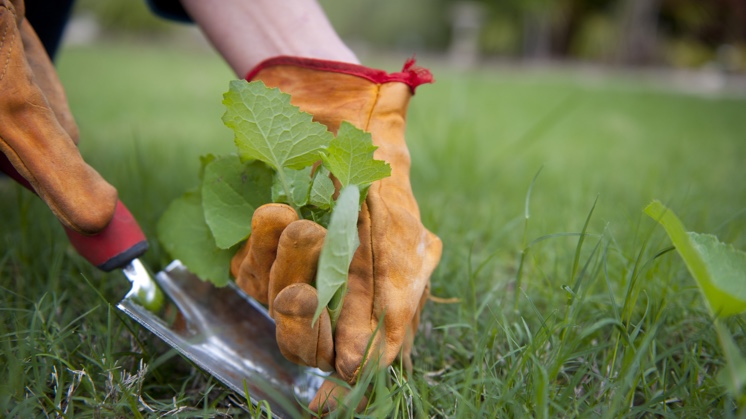Are you tired of constantly battling with weeds in your garden? Using a garden hoe can be the solution you've been looking for. This versatile tool allows you to easily remove weeds by cutting them at the roots, preventing them from regrowing.
With a garden hoe, you can maintain a weed-free garden without the need for harmful chemicals. Let's explore how a garden hoe can be your go-to tool for weed control and help you achieve a flourishing garden all season long.

Credit: www.facebook.com
Choosing The Right Garden Hoe
When it comes to effectively tackling weeds in your garden, choosing the right garden hoe is crucial. It can make your weeding tasks easier and more efficient, helping you maintain a well-kept garden effortlessly.
Consider The Types Of Garden Hoes
There are different types of garden hoes to choose from, each designed for specific purposes. Select the hoe type that suits the size and type of weeds in your garden.
Evaluating Handle Length And Material
Handle length is important for comfort and control, while the handle material should be durable to withstand regular use. Ensure the hoe's handle suits your height and grip preference.

Credit: www.iberdrola.com
Proper Technique For Weed Control
When it comes to effectively controlling weeds in your garden, using a garden hoe is a popular and efficient method. Understanding the correct technique is essential for successful weed control using a garden hoe.
Understanding The Correct Angle
Hold the garden hoe at approximately a 45-degree angle to the ground to ensure proper cutting depth without damaging the roots of desirable plants. Maintain a consistent angle for efficient weed removal.
Using The Right Motion
Employ a push-pull motion with the garden hoe to slice through weeds effectively. Ensure that the entire blade makes contact with the soil to remove weeds completely.
Maintenance Of Garden Hoe
To maintain your garden hoe for effective weed removal, regularly clean the blade after each use to prevent rust. Sharpen the edge with a file for efficient cutting and store it in a dry place to prolong its lifespan. Regular maintenance ensures your garden hoe remains in top condition for tackling weeds.
Maintenance of garden hoe is essential to ensure its optimal performance and longevity. It involves regular cleaning, drying after use, and blade sharpening. Proper maintenance of your garden hoe will not only help keep your garden neat and weed-free, but it can also save you time and effort in the long run. Cleaning and Drying After Use Cleaning your garden hoe after each use is crucial in preventing rust and prolonging its lifespan. Use a stiff-bristled brush or a wire brush to remove any soil, debris, or plant residue from the blade and handle. After cleaning, rinse the hoe with water to ensure all dirt and grime are removed. Then, thoroughly dry the hoe with a clean cloth or towel to prevent the formation of rust. Sharpening the Blade Regularly sharpening the blade of your garden hoe is essential to maintain its cutting efficiency and effectiveness. Use a metal file or a sharpening stone to sharpen the blade, ensuring that you maintain the original bevel angle. Gently run the file or stone along the cutting edge of the blade to remove any dullness or nicks. Be sure to test the sharpness of the blade carefully once sharpening is complete. By following these maintenance tips, you can ensure that your garden hoe remains in top condition, ready to tackle weeds and other gardening tasks with ease.
Credit: www.lowes.com
Weed Control In Different Soil Types
When it comes to maintaining a weed-free garden, understanding how different soil types affect weed growth is essential. Weeds can be especially persistent in certain soil conditions, such as clay or sandy soil. In this post, we will discuss effective techniques for weed control in different soil types, focusing on adapting to clay soil and managing sandy soil.
Adapting To Clay Soil
Clay soil can be a challenge when it comes to weed control. Due to its heavy texture, clay soil tends to become compacted, making it difficult for water and air to reach the plant roots. This leads to poor drainage, which creates an ideal environment for weeds to thrive. However, with the right approach, you can still keep those pesky weeds at bay.
Here are some tips for weed control in clay soil:
- Prepare the soil: Before planting, it's crucial to improve the soil structure. Add organic matter, such as compost or well-rotted manure, to clay soil. This will help break up the compacted soil and improve drainage.
- Mulch: Apply a layer of organic mulch around your plants to suppress weed growth. Mulch helps to smother existing weeds and prevents new ones from germinating.
- Hand pulling: Regularly inspect your garden for any emerging weeds. Pull them out by hand before they have a chance to set deep roots. Remember to wear gardening gloves for protection.
- Use a hoe: A garden hoe is a valuable tool for weed control in clay soil. Choose a hoe with a sharp blade and use it to chop off weeds at the soil surface. Be careful not to disturb the plant roots.
- Weed barriers: Installing weed barriers, such as landscape fabric or plastic mulch, can effectively prevent weeds from germinating and growing in clay soil.
Managing Sandy Soil
Sandy soil, on the other hand, is typically well-drained but lacks essential nutrients. These conditions can make weed control a bit challenging, as weeds tend to find it easier to establish themselves in sandy soil. However, with the right strategies, you can keep your garden weed-free even in sandy soil.
Here are some techniques for managing weeds in sandy soil:
- Improve soil fertility: Sandy soil often lacks essential nutrients. Boost the fertility of sandy soil by adding organic matter, such as well-rotted compost or aged manure. This will provide the necessary nutrients for your plants to grow strong and healthy, outcompeting weeds.
- Mulching: Apply a generous layer of organic mulch to sandy soil. This will help conserve moisture and suppress weed growth. Choose mulch materials that won't break down quickly in sandy soil, such as wood chips or straw.
- Water deeply and infrequently: Sandy soil drains quickly, so it's important to water deeply to ensure the water reaches the plant roots. By doing so, you encourage deeper root growth and discourage weed establishment.
- Pull weeds early: Act promptly when you spot weeds in sandy soil. Weeds can spread rapidly, so removing them early on prevents them from competing with your desired plants for resources.
- Use herbicides selectively: In some cases, using herbicides may be necessary to control persistent weeds in sandy soil. However, it's important to do extensive research and follow the instructions carefully to avoid harming desirable plants.
Advanced Tips For Efficient Weed Control
When it comes to maintaining a beautiful and weed-free garden, having the right tools and techniques is crucial. Among the arsenal of tools, a garden hoe for weeds is a must-have. While using a hoe may seem straightforward, there are advanced tips that can enhance its efficiency and make your weed control efforts more effective. In this post, we will explore two advanced techniques that can take your weed control to the next level: utilizing mulch as a supportive tool and combining chemical-free techniques.
Utilizing Mulch As A Supportive Tool
Mulch is not just a decorative addition to your garden; it can also act as a helpful tool in weed control. By using mulch strategically, you can create a barrier that suppresses weed growth, conserves moisture in the soil, and provides insulation for plants.
Mulch works by blocking sunlight from reaching weed seeds, preventing them from germinating and thriving. Additionally, it reduces the amount of space available for weeds to grow, making it harder for them to establish a foothold in your garden.
To utilize mulch effectively for weed control, consider the following:
- Choose the right type of mulch: Organic mulch, such as wood chips or straw, is ideal for promoting soil health while also serving as a weed deterrent. Opt for mulch that is free from weed seeds to avoid unintentionally introducing new weeds into your garden.
- Apply mulch correctly: Spread a layer of mulch around the base of your plants, ensuring it is at least 2-3 inches deep. This thickness will provide maximum weed control benefits and help retain moisture in the soil.
- Maintain mulch regularly: Over time, mulch may decompose or get displaced, reducing its weed-suppressing abilities. Keep an eye on your mulch and replenish it as needed.
Combining Chemical-free Techniques
Many gardeners prefer to avoid using chemical herbicides for weed control due to their potential negative impact on the environment and beneficial insects. Fortunately, there are several chemical-free techniques that can be combined with hoeing to effectively manage weeds in your garden.
Here are some techniques to consider:
- Hand-pulling: For smaller weeds or isolated patches, manually removing them by hand can be effective. Ensure that you remove the entire root system to prevent regrowth.
- Smothering: Covering the soil with a thick layer of cardboard or newspaper can smother existing weeds and prevent sunlight from reaching weed seeds. Add a layer of mulch on top to enhance the smothering effect.
- Regular maintenance: Consistent weeding and hoeing can keep weed populations in check, preventing them from becoming established and spreading throughout your garden.
- Plant spacing: Providing adequate spacing between plants helps reduce competition for resources, making it harder for weeds to thrive.
By combining these chemical-free techniques with the use of a garden hoe for weeds, you can create a comprehensive weed control strategy that is safe, effective, and environmentally friendly.
Frequently Asked Questions For Garden Hoe For Weeds
What Is A Garden Hoe Used For?
A garden hoe is a versatile tool used for breaking up soil, removing weeds, and creating furrows for planting seeds. It helps in keeping the garden clean and promoting healthy plant growth.
How Does A Garden Hoe Remove Weeds?
The sharp blade of a garden hoe is used to chop through the base of the weeds, severing their roots from the soil. By pushing and pulling the hoe back and forth, you can effectively remove weeds without damaging the surrounding plants.
What Types Of Weeds Can A Garden Hoe Remove?
A garden hoe can effectively remove a wide range of weeds, including annuals, perennials, and grassy weeds. It is particularly useful for removing shallow-rooted weeds, such as dandelions, pigweed, and crabgrass.
Is A Garden Hoe Better Than Hand-pulling Weeds?
Yes, a garden hoe is often a more efficient and effective method for removing weeds compared to hand-pulling. It allows you to cover a larger area and remove weeds before they have a chance to establish deep roots.
Conclusion
Incorporating a garden hoe to manage weeds is essential for maintaining a flourishing garden. By efficiently removing unwanted plants, you can improve the overall health and aesthetics of your garden. With the right tool and technique, you can achieve a weed-free space that enhances the beauty of your outdoor space.

0 Comment to "Garden Hoe for Weeds: Master the Art of Weed Control"
Post a Comment